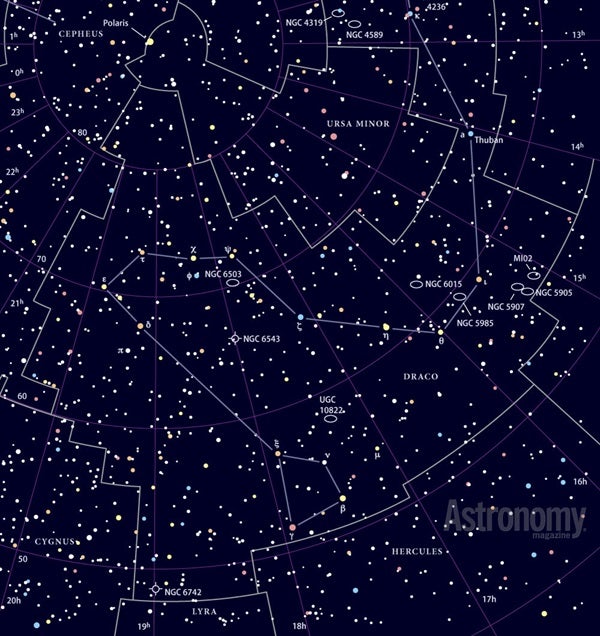Targets for June 4–11, 2015
Naked eye:
The Purkinje effect
Large telescope:
The White-eyed Pea (IC 4593)
Large telescope:
Spiral galaxy NGC 5985 and companions
This week’s first object isn’t an object at all — it’s an optical illusion called the Purkinje effect. For observers, it most often manifests as a tendency of the eye to perceive blue objects as brighter than red ones even though both are at the same brightness.
Czech physiologist Jan Evangelista Purkinje discovered this effect in 1819. He noticed that certain flowers appeared bright red during a sunny day and dark red or even black when illuminated only by dusk. He found, in essence, that the eye’s sensitivity shifts toward the blue as the illumination decreases.
You can demonstrate the effect the next clear night by comparing two bright stars — Arcturus (Alpha [α] Boötis) and Vega (Alpha Lyrae). It’s best if you view them when both stand roughly the same distance above the horizon. That way, dimming caused by the atmosphere will affect both stars the same amount. In early June, that’s around midnight local daylight time.
Which star is brighter? If you see Vega as brighter — and just about everyone does — you’ve demonstrated the Purkinje effect. In reality, Arcturus is the brighter of the two, but not by much. It outshines Vega by a mere 0.07 magnitude. Essentially, they’re the same brightness.
The human eye, however, perceives Vega as slightly brighter because it’s blue. You can try this with any red and blue stars as long as they’re nearly the same brightness and you view them at the same distance above the horizon.
Faint pea in a pod
This week’s first large-scope object is the White-eyed Pea, a planetary nebula in Hercules. It also goes by the designation IC 4593.
You’ll find it 3.9° west-southwest of magnitude 4.6 Omega (ω) Herculis. Although this deep-sky object has a common name, you’ll need more than just a common telescope to see much detail here. It glows at magnitude 10.7, but it’s tiny — only 42″ in diameter. Telescopes smaller than 8 inches show only the magnitude 11.1 central star.
Through a 16-inch scope, the halo that encases the central star appears blue. Magnifications above 350x show the halo has a slight oval shape in a northwest to southeast orientation. For the best view through your scope, be sure to place magnitude 7.7 SAO 101998, which lies 11′ to the south-southeast, outside your eyepiece’s field of view. Otherwise, the relative brightness of that star will overwhelm the planetary.
Three for the price of one
This week’s second large-telescope target is spiral galaxy NGC 5985 in the constellation Draco the Dragon. It glows at magnitude 11.1 and measures 5.3′ by 2.9′.
This object is a nice deep-sky treat on its own, but it teams up with the magnitude 12.0 elliptical galaxy NGC 5982 and the magnitude 13.2 spiral galaxy NGC 5981 for one remarkable view. These three objects lie in an east-west line less than 14′ apart. You’ll find this trio 1.8° east-northeast of magnitude 3.3 Iota (ι) Draconis.
To spot any detail in the spiral arms of NGC 5985, you’ll need at least a 12-inch telescope. The other two galaxies won’t reveal small details, except through the largest amateur scopes. NGC 5981 is another nice example of the universe’s “needle” galaxies. To see the entire trio, use a magnification around 100x.
Expand your observing at Astronomy.com
StarDome
Check out Astronomy.com’s interactive StarDome to see an accurate map of your sky. This tool will help you locate this week’s targets.
The Sky this Week
Get a daily digest of celestial events coming soon to a sky near you.
Observing Talk
After you listen to the podcast and try to find the objects, be sure to share your observing experience with us by leaving a comment at the blog or in the Reader Forums.











